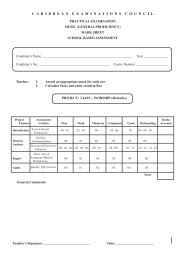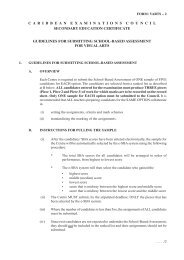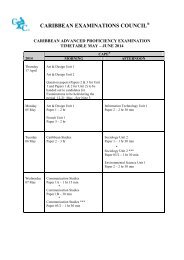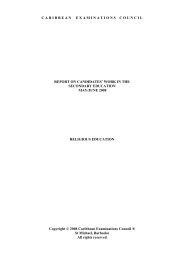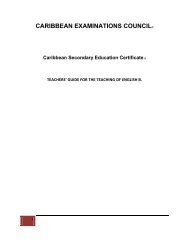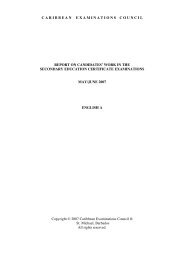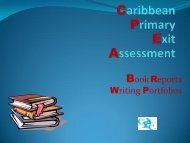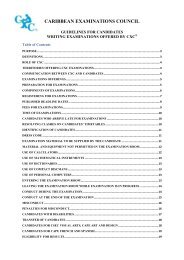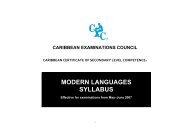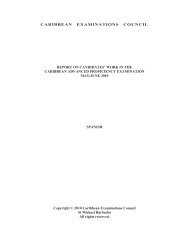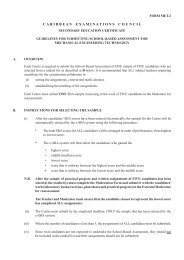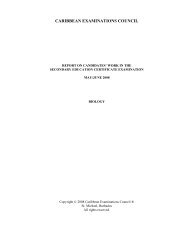The <strong>Caribbean</strong> <strong>Examiner</strong><strong>CXC</strong> Examination SystemUnderstandingIn many ways, <strong>CXC</strong>’s examination system is unique, robust and internationallyacclaimed. This section gives you an insider’s perspective on the system.Continuous AssessmentBy Desmond Broomes, PhDContinuous Assessment: Integrating keyconcepts into a cartesian spaceContinuous assessment is an approach toassessment which enables the teacher to use awide range of methods to gather informationabout learners from a variety of sources. Airasian(1996) having explored the research literature inassessment in the classroom, defined continuousassessment to include about seven criticalfeatures, namely:1. using a variety of assessment toolsranging from a quiz to a project,2. collec ting data, formally andinformally, from different and variedsources,3. spanning the cognitive, affectiveand psychomotor features of thelearners,4. conducting and sustaining teachinglearning-assessmentactivities overan extended period of time,5. mapping the growth and developmentof the persons being assessed,6. using and maintaining a holistic viewof the learner,7. employing formal as well as informalapproaches conducted by externaland internal agents (teachers andexaminers) and complementedby data collected and analysed bythe learners themselves; in orderto enable teachers to understandtheir students as learners, to planand monitor the learners’ academicachievement and to encourage theemergence of high self-concept andself-reliance among learners.Classroom teachers (and their collegetutors) have long assumed that there exists adynamic nexus among positive self-concept andself-reliance and academic achievement. Theassumption has been researched and maintainedby Brookover and associates about three decadesago (Brookover and Lezotte, 1979).Continuous assessment attempts to validatethis assumption as part and parcel of theclassroom environment. Teachers who attendedcourses at a teachers’ college have studied someof these features and have practised at least oneof them in a <strong>Caribbean</strong> classroom. The challenge,however, is to encourage teachers who work inclassrooms during the second decade of the 21 stcentury to link together four, five or six of thesefeatures that are associated with continuousassessment.Many advantages flow from continuousassessment as conceptualised in this articleand as defined by Airasian (1991). Four salientadvantages endorsed by teachers are:1. Continuous assessment involvesgathering data over a period of time,under a variety of conditions. Thus,it is reasonable to expect that a moreaccurate measure of the learner’scharacteristics will emerge.2. The way the data are collected playsa critical role in diagnosing andremediating the learner’s weaknessesand needs and ensuring that thelearner plays meaningful roles inunderstanding the nature of the“gap” and also in “feeding forward”to defining “what’s next?”3. Continuous assessment spans thelearner’s progress systematicallyand holistically, and enables theclassroom culture to motivate theemergence of certain desirablebehaviours among all students andtheir peers.4. A big advantage of continuousassessment derives from the centralrole of the teacher in a formativeassessment environment.Thinking ‘formative assessment’ as a majorcomponent or expression of what constitutescontinuous assessment encourages teacherparticipation in fusing together teaching,learning and assessment. It also guides teachersin constructing ‘feedback’ as skilful tools inmotivating learners to reach for the next level.For the teacher, the ‘next level’ requires a sensitiveunderstanding of how data may be interpretedand synthesised to define “feed forward” skills.Continuous assessment is integrated withteaching and learning in order to improve whatstudents learn and how they learn and to helpteachers reshape and redirect their teachingprocess, so as to1. give each student more responsibilityfor recognising the “gap” betweenwhat he/she has learnt and thegoals of the lesson as taught by theteacher; and also to define whatactivity the student (and the teacher)should engage next in order to closethe identified gap and go beyond thespecified goals.2. enable the teacher to redirect andreformat the teaching and theguidance by making use of newunderstanding of the nature of thetask and its interactions with thestudents.The assessment is continuous: it occursat various times as part and parcel of teachingand learning. It may occur at the beginningof the lesson, during the lesson, following thelesson. It may occur at the beginning of thetopic, during the presentation of the topic andat the end of the topic. Continuous assessmentas it occurs at various times provides regularand immediate information to the teacher andto the students about the teaching, the learning,and the achieving of the learning objectives andcontent. Most importantly, it allows for teachersand students to engage, within the classroomand among the students who reside in theclassrooms, in performance-based activitiesthat are difficult to assess under summativeassessment environments and artificial frames(as frequently observed in dull classrooms).Continuous assessment undergirds the modelthat emphasises formative assessment coupledwith a sensitive feedback methodology asadvocated in the <strong>Caribbean</strong> Primary ExitAssessment (CPEA) project launched by <strong>CXC</strong>in 2011.Most psychometricians extol authenticassessment as one golden way to ensure reliableand valid scores. Authentic assessment is said18 MAY <strong>2012</strong> www.cxc.org
The <strong>Caribbean</strong> <strong>Examiner</strong>Understanding Continuous Assessmentto occur when the tasks to be engaged by thestudents are similar to tasks usually encounteredin the real world. Continuous assessment, byits definition and its procedures, stimulates theemergence of authentic assessments within aschool programme.Continuous assessment provides a way ofviewing assessment that integrates at least fiveperspectives of assessment. It emphasises theadvantages of viewing assessment activities as:1. formative along a formativesummativecontinuum of activities2. internal along an internal-externalcontinuum3. informal along an informal-formalcontinuum4. process along a process-productcontinuum, and also5. divergent along a divergentconvergentcontinuum.Brief defining statements of these modesof assessment should serve to convey a sense ofthe size and scope and structure of continuousassessment, as practised by <strong>CXC</strong>.1. Formative vs. summativeFormative assessment, designed toinform teachers about future teachingand students about future learning.Summative assessment, designedto produce a summary of what thestudent has learnt and can do withina domain usually specified by asyllabus.2. Internal vs. ExternalInternal assessment - where theassessment is done by someonewithin the school setting, usually theclassroom teacher.External assessment, where the tasksare devised and set by persons outsidethe school setting, sometimes by ateacher from another school.3. Informal vs. FormalInformal assessment - where theassessment is conducted most oftenduring the teaching-learning activitiescarried out daily in classrooms.Formal assessment-where theassessment is usually conducted as aset of discrete and highly structureddata-collection tasks; tasks are set tofit given specifications and to be donein a set time.4. Process vs. ProductProcess assessment - where theassessment is focused on what isbeing done in real time and usuallyrequire the presence of an examineror teacher.Product assessment where theassessment is focused on assessingwhat has been produced in the formof concrete, tangible objects to fitgiven criteria.5. Divergent vs. ConvergentDivergent assessment – where theresponses of the learners to tasks areexpected to span a range of answerswhose quality is to be judged by thenature of the analysis and soundnessof opinion. However, the responsesrequire highly trained marking skillsor at least sensible rubrics, flexiblyconstructed.Convergent assessment is aboutassessment which is generally easyto mark, by machines or by persons.Wherever knowledge or mere recallof facts is the primary concern,convergent assessment is valid andrapid.Continuous assessment is a unitary conceptintegrating the activities that are defined bythe three axes associated with the formativesummativecontinuum, informal-formalcontinuum and internal-external continuumactivities (see Figure 1).The space which this miniature symbol(see figure below) attempts to represent is thecartesian space of interest known as continuousassessment. Our senses and everyday experiencesenable us to form easy images of a 3-dimensionalspace. Nevertheless it seems more useful andsatisfying to think of the space of interestspanning as many as five dimensions, namely• Formative - summative• Internal - external• Informal - formal• Process - product• Divergent - convergentContinuous assessment is an on-goingassessment of all pupils throughout a Grade 5 orGrade 6 programme, for example. It involves theschool, teachers, students and teachers’ colleges.Its purposes are:1. a) encouraging studentinvolvement and motivationb) involving parents in the tasksdone by studentsc) encouraging parentalinvolvement at many levels2. a) monitoring and providingfeedback to students on theirprogressb) linking tasks done in school totasks done in homes and thecommunityFIGURE 1: Rectangular axes defining a continuous assessment spacewww.cxc.org MAY <strong>2012</strong> 19



